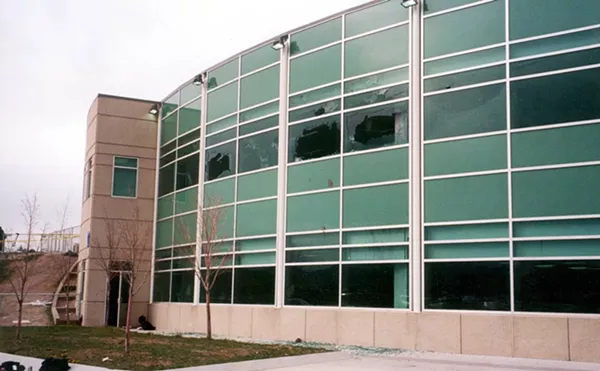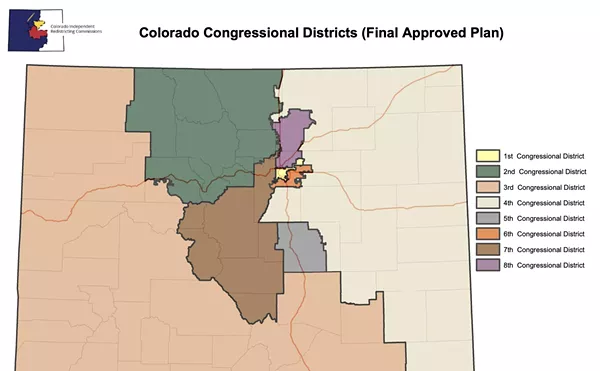"Goddamn it," one sighed.
"Aw, man," lamented another, throwing his board in the dirt. "Shit!"
"Why is everyone wearing helmets?" asked the third, before realizing the rhetorical-ness of his question.
When the trio reached the skatepark's entrance, their suspicions were cemented. Rule number two, already half scratched out by some angry vandal with a car key: "Helmets are required."
On the north end of the course, a somber-faced cop stood next to his black mountain bike and issued a lanky teenager a citation for lack of a helmet. After the officer pedaled away toward the complex of softball fields, one preteen kid immediately assumed the role of lookout, screeching "Cop! Cop!" every time the 5-0 descended from the highlands on mountain bikes or rolled by in the black-and-white. And every time, half a dozen helmet-less skaters scattered for cover.
For many older, hard-core skaters, who had been closely following the development and design of the $370,000, 15,000-square-foot skatepark, the regulation was an unexpected bummer. Not because they hated wearing the brain buckets, but because they hated being watched over by a bunch of babysitters with nightsticks. One rider, who looked to be in his mid-thirties, complained loudly into his cell phone about the police presence. "These cops are out of control," he said, looking up at the cruiser camped out at the top of the hill. "We're just trying to skate."
The City of Westminster began planning the park in 2000, but tossed the idea when Vans, the skateboard shoe company, opened a 55,000-square-foot indoor skatepark at the nearby Westminster Promenade in 2001. The facility was a skate-topia of banks and bowls, but the corporation overestimated the skate population's willingness to pay $15 for a two-hour session while kowtowing to its strict full-pad-and-helmet rule. The park crashed in 2003, and Westminster hired local landscape-architecture firm Architerra to fill the void.
The group had earned a mixed reputation among skateboarders because of the mediocre layouts of earlier skatepark projects in Lakewood and Federal Heights ("Skate Nation," August 28, 2004). But by borrowing heavily from the collective wisdom of some local skaters, Architerra absolved itself of past sins with Westminster's praiseworthy design. The street-course section is cramped but fun, featuring stairs, rails, a Euro-gap and a well-angled pyramid. But it's the unique ten-foot-deep bowl -- with concrete pool coping, an over-vert shell and a formidable love seat -- that ups the gnarly factor and puts Westminster on par with the Front Range's top skateparks in Aurora, Denver, Boulder and Fort Collins.
What was holding the Westminster skatepark back was the helmet rule. "You know, people can break arms and legs -- and I'm not saying that those aren't significant things -- but head injuries are where there's going to be significant change of life to people," says Marty Erickson, the city's risk manager, who was responsible for the helmet rule and who oversees insurance and liability issues. "So as far as I'm concerned, as the risk manager, I would want the head to be protected above everything else."
Erickson was also following the recommendation of the Colorado Intergovernmental Risk Sharing Agency, which provides insurance to Westminster as well as nearly every municipality in the state. The group publishes the Skate Park Safety Guidelines Handbook, which includes information on injury statistics, liability exposures and governmental protection, and advises cities to require helmets at public facilities.
But most cities don't heed the warning. Denver only "strongly encourages" the use of helmets, because Parks and Recreation Department planner Mark Bernstein says he was advised by city attorneys to stay as hands-off as possible in regulating the 60,000-square-foot concrete skatepark, which is the biggest in the United States. "Even though the skatepark is very unique in its functionality, we in the Parks and Rec department view it no differently than any other public open space in our parks system," he says.
This line of legal thinking reasons that if a city requires the use of safety equipment, it actually opens itself up to more liability because it is required to enforce that mandate. "A lot of times, cities will get scared and try to exert too much control and end up digging themselves into a bigger hole," says Chad Balcom, the northwest regional director for Skaters for Public Skateparks, a national skatepark-advocacy organization. "First they require pads, but then they need to have someone there to enforce it, so they hire monitors. But then they need to pay the monitors, so they put a big fence around it and charge fees. Eventually, you have a skatepark that none of the skaters want to go to anymore when they could skate a parking lot. So then what's the point of even having a skatepark?"
Even with only strongly encouraging Denver skaters to use helmets, Bernstein says that no injuries have been reported at the skatepark. Much of this he attributes to what he calls the "badge of courage factor," where skaters don't file grievances with authorities over injuries suffered. Though skinned elbows, sprained ankles and broken wrists can be common at skateparks, skateboard culture considers taking such slams to be an inevitable part of the activity. And with hundreds of users riding the park from sunup to 11 o'clock at night, when the lighting system shuts off, enforcing any kind of helmet rule at the Denver park would have certainly been a daunting -- if not impossible -- task, accomplishing nothing but increased animosity between skaters and police.
This realization came quickly to Westminster city management. Only three of the $25 tickets were issued to skaters at the Westminster park, but a week after it opened on May 11, the city decided to reverse its decision and just make helmets "strongly recommended." Parks Services manager Richard Dahl says they discovered it was much too difficult to make everyone comply with the rule, since there are only two police officers assigned to patrol all public parks and buildings. "We were concerned about the amount of time it would take to enforce the helmet rule," he says, adding that they instead opted to try to balance between "what the users want and what is the acceptable amount of risk that the city is willing to assume."
On the afternoon of May 17, the day the rule was changed, the Westminster Skate Park was a very different scene than it had been two weeks earlier, when the three twenty-something friends had visited. It was another beautiful afternoon, but the cops were nowhere in sight. Out of the fifty people there, about a dozen were wearing helmets -- mostly in the bowls, this time by choice.
And no one was on lookout.












